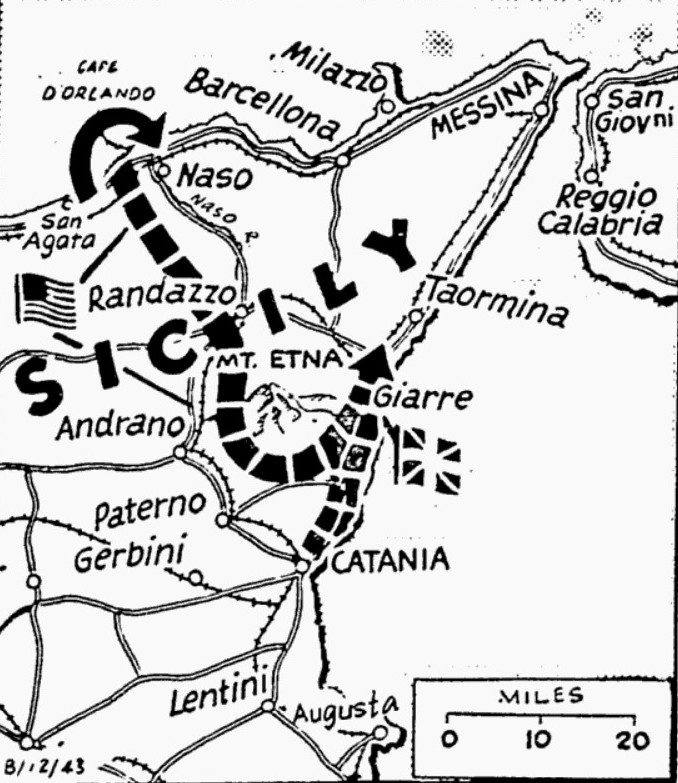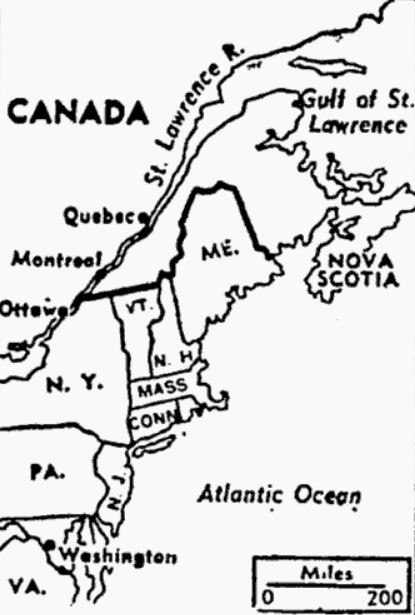The Pittsburgh Press (August 12, 1943)
YANKS FLANK NAZIS BY SEA
Germans reported evacuating Sicily
Landing ruse pinches off Germans

The Germans are outflanked again as units of Gen. George S. Patton’s 7th Army stage a second landing behind German lines in Sicily, and today the troops were reported locked in bitter battles with the Nazis. Protected by naval guns, the troops landed near the mouth of the Naso River (see map above), west of Capo d’Orlando, and established a beachhead only some 40 miles from Messina. Meanwhile, the main body of Americans was just west of Capo d’Orlando, putting the Nazi forces between two fires. The strategic mountain town of Randazzo was also feeling the force of the Americans’ might, the Yanks being reported within three miles of the town, with its fall imminent. On the right wing, British 8th Army forces moved slowly but steadily up the coastal corridor of the slopes of Mt. Etna. Advance elements were at least 15 miles north of Catania.
U.S. II Corps HQ, Sicily, Italy (UP) –
A U.S. battalion that landed eight and a half miles behind the German lines on the north coast of Sicily joined the main body of U.S. infantry today after beating off savage enemy counterattacks from front and rear.
The landing force pinched off a sizeable number of German and Italian prisoners as they fought their way through to Lt. Gen. George S. Patton’s 7th Army infantry swarming eastward along the coastal road to Messina, now on more than 40 miles away.
It was not known immediately in what strength the junction was effected.
A British correspondent with the 8th Army reported that a German evacuation of Sicily “now is in full swing,” with all types of craft shuttling across the Strait of Messina under cover of a terrific anti-aircraft barrage, but added that the withdrawal had not reached the scope of a mass evacuation.
Military sources in London said the Germans appeared to be evacuating about 1,000 troops a day from Sicily. The Germans were reported using ferries and all types of craft, under cover of a terrific anti-aircraft barrage from 300 guns which limited accuracy of Allied air attacks.
It was the identical force which hit the Axis flank at dawn Sunday east of Sant’Agata that crashed in to establish a new beachhead in the early hours of Wednesday.
Hit beaches on the run
This force hit the beaches on the run, cut the main road, took “considerable” prisoners, then headed into the mountains where the Germans clung tenaciously to dominant bluffs overlooking the sea.
When first radio contact between the troops and the main attacking forces had been established, it was learned the landing force had surprised the enemy, taken prisoners and established the beachhead.
Meanwhile, part of the main attacking army from the west pushed along the coastal road, while a column on the right flank of the main road cut through the mountains, jumped astride the northside road (apparently the highway from Naso to Randazzo) and then worked northeastward toward the landing party.
A big jump
This second landing represented a jump of about three more miles than the first six-mile flanking maneuver Sunday, so that the distance separating the two U.S. forces would be wide enough to permit heavy sea and aerial pounding of the enemy.
The Navy sent ashore a fire-control party to accompany the landing forces. Army auxiliary men praised the accuracy of the naval gunners.
The German High Command admitted today that U.S. troops had made a second landing on the northeastern coast of Sicily, west of Capo d’Orlando, but said the largest part of the force had been prevented from landing and the rest was “annihilated” on the beaches.
Southward, at the middle of the yielding Axis defenses across the tip of Sicily, the 7th Army’s right wing pushed within light artillery range of Randazzo, key junction commanding the pass between Mt. Etna and the Caronian Mountains. The Americans were reported meeting nothing stronger than light artillery fire.
NBC said the Americans were within three miles of Randazzo, and the fall of the strategic mountain town was imminent.
On the Allied right wing, the British 8th Army plugged slowly but steadily up the coastal corridor on the slopes of Mt. Etna. Advanced elements reached a point at least 15 miles north of Catania, taking the neighboring villages of Praiola and Zafferana, 41 miles south of Messina.
A German communiqué said Axis forces in Sicily had carried out “according to plan” certain “disengaging movements toward a shortened bridgehead” – an acknowledgement of a large-scale withdrawal.
U.S. Flying Fortresses, again carrying the war to the Italian mainland, plastered the Terni railroad and highway hub 40 miles north of Rome with explosives which wrecked factories, arms plants and transport facilities.
Second bold stroke
The second bold strike behind the German lines along the north coast of Sicily was carried out in the early hours of Wednesday. Supporting it was fire from U.S. naval units, including cruisers and destroyers, and bombers of the North African Air Forces.
The landing near the mouth of the Naso River east of Capo d’Orlando was made in the face of stiff German resistance. Put on the alert by the Sunday morning foray, which crumpled the north end of their defense line, the Nazis were ready and waiting.
The second leapfrog move toward the complete conquest of Sicily was aimed at the mouth of the Naso River because it offered a natural mooring for the troops going ashore in small barges and landing craft.
After the landing, U.S. ships offshore laid down a paralyzing bombardment of German positions slightly inland.
Drive on Randazzo
U.S. units pushing along the Randazzo road from Cesarò were within light artillery range of the vital junction town by 4 p.m. yesterday.
The concerted British 8th Army push from Bronte was meeting stiff resistance midway between Bronte and Randazzo.
All along the line, the Axis forces were beginning to show signs of fatigue and shortage of food and water. Tactical air forces had made virtually useless all the roads leading to Randazzo, where the Axis plight was especially taken.

